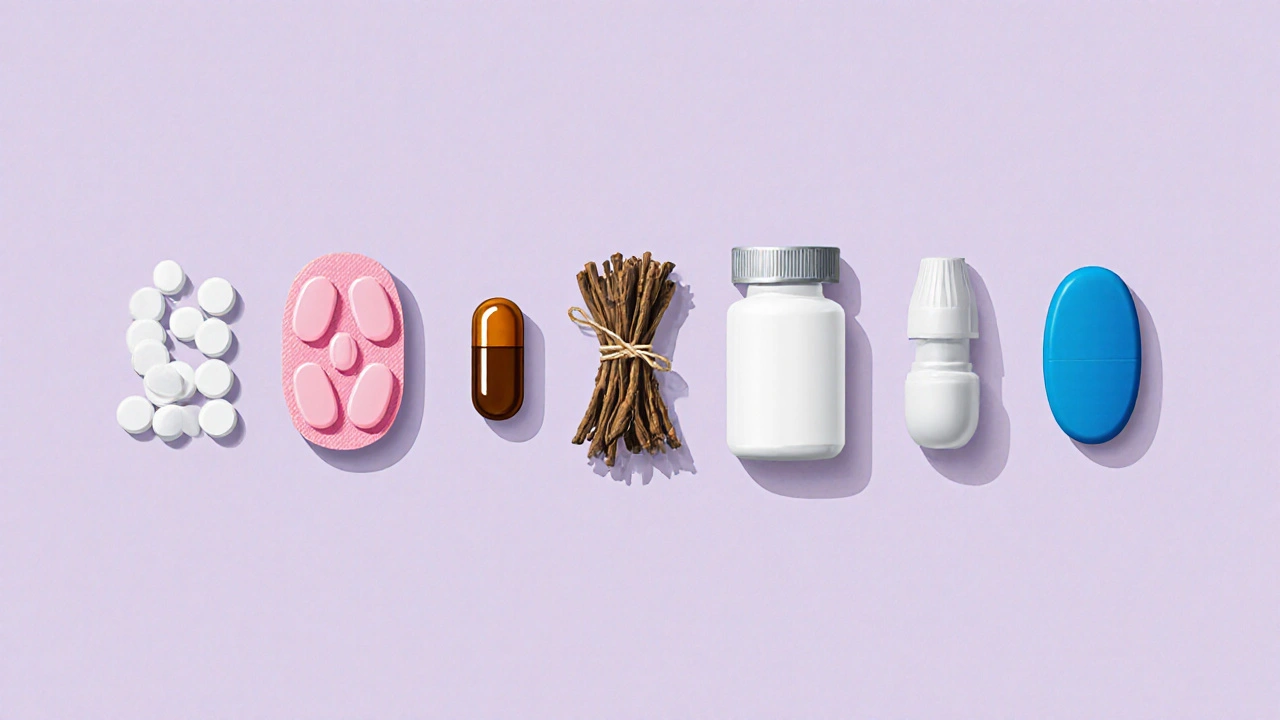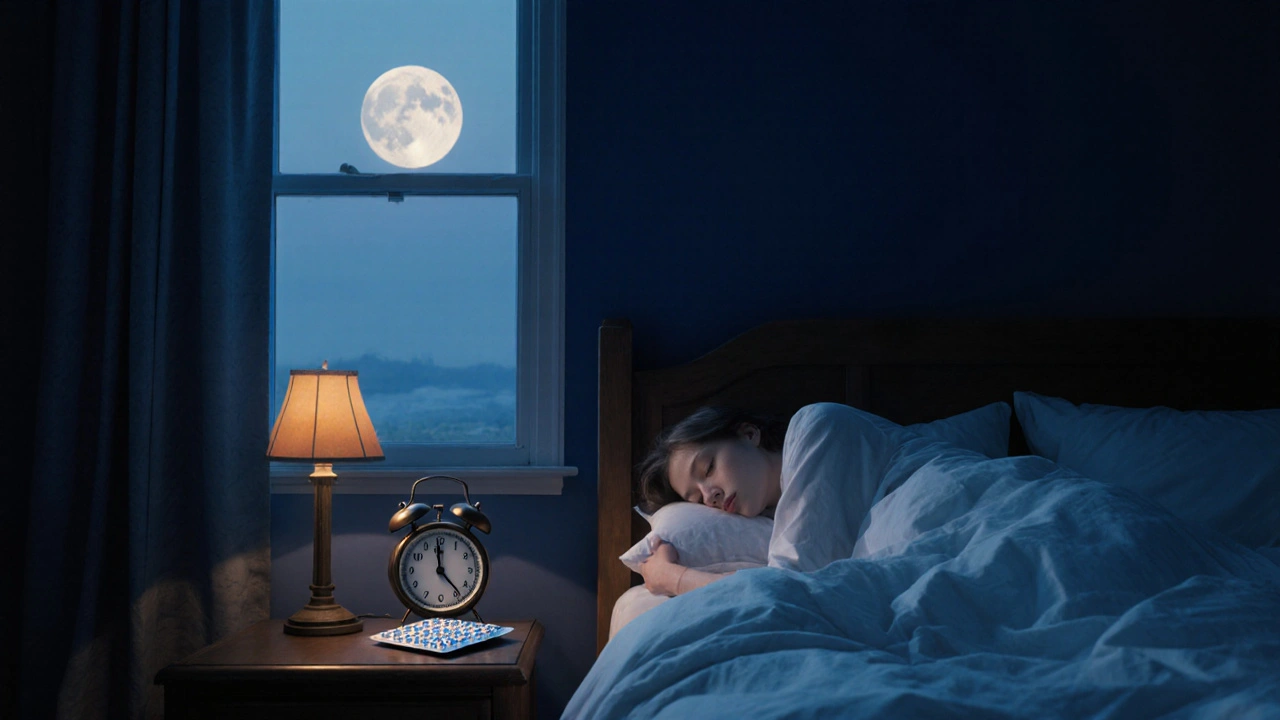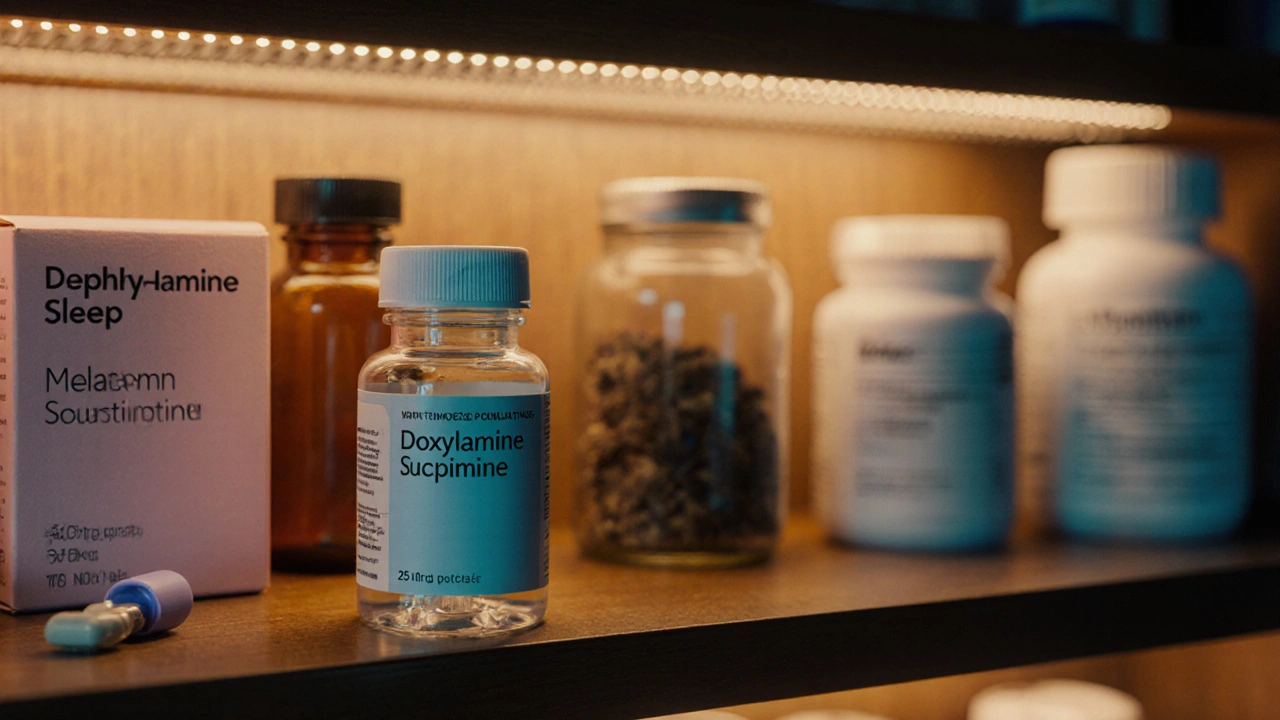OTC Sleep Aid Selector
Recommended Sleep Aid:
Why This Choice:
When you’re hunting for an over‑the‑counter sleep aid, the shelves are full of options - some are antihistamines, others are herbal extracts, and a few are synthetic melatonin. Doxylamine Succinate is an older antihistamine that doubles as a powerful nighttime aid. This article breaks down how it stacks up against the most common alternatives so you can pick the one that fits your schedule, health profile, and budget.
Key Takeaways
- Doxylamine works by blocking histamine receptors, causing strong drowsiness that lasts 6‑8hours.
- Diphenhydramine is similar but has a quicker onset and a slightly higher risk of next‑day grogginess.
- Melatonin aligns with your natural sleep‑wake cycle but is less sedating for people with severe insomnia.
- Herbal options like Valerian root are gentle but often need a few weeks of consistent use.
- Prescription‑only agents such as Zolpidem provide the strongest sleep induction but carry higher dependence risk.
What Is Doxylamine Succinate?
Doxylamine Succinate belongs to the first‑generation antihistamine class. It was first approved in the 1940s and has since become a staple in many nighttime cold‑and‑flu formulas. The drug blocks H1 histamine receptors in the brain, which not only reduces allergic symptoms but also triggers sedation. Typical adult dosing for sleep is 25mg taken 30minutes before bedtime, with effects kicking in within 30‑60minutes and lasting up to eight hours.
How Doxylamine Differs From Other Antihistamine Sleep Aids
The most direct competitor is Diphenhydramine, the active ingredient in Benadryl and many OTC sleep products. Both drugs share the same H1 blocking mechanism, but diphenhydramine usually peaks faster (15‑30minutes) and wears off sooner (4‑6hours). This makes diphenhydramine a better choice for people who only need a short night of rest, while doxylamine’s longer hang‑time suits longer sleepers.

Alternative Sleep Aids at a Glance
Below is a side‑by‑side look at the most popular non‑prescription options. Attributes such as onset, duration, typical dose, and safety notes are based on US FDA labeling and recent clinical reviews (2023‑2024).
| Ingredient | Drug Class | Typical Dose | Onset | Duration | Key Side Effects | Pregnancy Safety (US FDA) |
|---|---|---|---|---|---|---|
| Doxylamine Succinate | First‑gen antihistamine | 25mg | 30‑60min | 6‑8hr | Dry mouth, constipation, next‑day drowsiness | CategoryB (no proven risk) |
| Diphenhydramine | First‑gen antihistamine | 25‑50mg | 15‑30min | 4‑6hr | Anticholinergic effects, next‑day fog | CategoryC (risk cannot be ruled out) |
| Melatonin | Hormone supplement | 0.5‑5mg | 30‑60min | 4‑7hr | Headache, mild dizziness | CategoryA (generally safe) |
| Valerian Root | Herbal sedative | 400‑900mg | 1‑2hr | 4‑6hr | Rare GI upset, possible withdrawal | Not classified (limited data) |
| Hydroxyzine | Prescription antihistamine | 25‑50mg | 15‑30min | 4‑6hr | Drowsiness, dry mouth, QT prolongation (rare) | CategoryB (used off‑label for insomnia) |
| Zolpidem | Non‑benzodiazepine hypnotic (prescription) | 5‑10mg | 15‑30min | 6‑8hr | Complex sleep behaviours, dependence | CategoryC (prescription only) |
When Doxylamine Is the Better Choice
If you need a night of uninterrupted sleep that lasts longer than seven hours, Doxylamine often outperforms diphenhydramine and melatonin. It’s also the go‑to for people who suffer from nighttime allergy or cold symptoms because it tackles both congestion and sleepiness in one pill. Brands like Unisom package doxylamine in 25mg tablets, making dosing straightforward.
When Another Option Might Suit You More
- Short naps or early‑morning awakenings: Diphenhydramine’s faster onset and shorter duration reduce the risk of grogginess.
- Pregnant or breastfeeding individuals: Melatonin (CategoryA) is generally considered safer than doxylamine, though the data is modest.
- Gentle, long‑term nightly routine: Valerian root or melatonin can be taken nightly without building tolerance, whereas doxylamine may lose potency after a few weeks of regular use.
- Prescription‑grade insomnia: Zolpidem or hydroxyzine provide stronger hypnotic effects, but they require a doctor’s approval and carry higher dependency risks.

Safety Tips and Common Pitfalls
Regardless of the product you choose, keep these rules in mind:
- Never combine two antihistamine sleep aids. The additive sedative effect can lead to severe respiratory depression.
- Avoid alcohol while using any of these agents - it amplifies drowsiness and impairs coordination.
- Be cautious with driving or operating machinery the morning after a dose of doxylamine or diphenhydramine.
- If you’re over 65, start with the lowest possible dose. Older adults are more prone to anticholinergic side effects such as confusion or urinary retention.
- People with glaucoma, enlarged prostate, or severe asthma should discuss antihistamine use with a clinician first.
How to Choose the Right Sleep Aid for You
Use this quick decision tree:
- Do you need a long‑lasting sleep window? → Doxylamine or Zolpidem.
- Do you have allergies or a cold that keeps you up? → Doxylamine (covers both).
- Are you pregnant, nursing, or want a natural product? → Melatonin or Valerian root.
- Do you need a short‑acting aid for occasional use? → Diphenhydramine.
- Is dependence a major concern? → Avoid Zolpidem, stick to melatonin or herbal options.
Track your sleep quality for at least a week after starting any new aid. If you notice persistent morning fog, headaches, or gastrointestinal upset, consider switching to a milder alternative.
Frequently Asked Questions
Can I use Doxylamine every night?
Occasional use (a few nights a month) is generally safe. Daily use can lead to tolerance, meaning you need higher doses for the same effect, and may increase anticholinergic load, especially in older adults.
Is Doxylamine safe for children?
The FDA does not recommend Doxylamine for children under 12years. For pediatric insomnia, melatonin (under pediatric guidance) is typically preferred.
How does Doxylamine compare to prescription Zolpidem?
Both provide 6‑8hour coverage, but Zolpidem is more potent, works faster, and is designed for chronic insomnia. However, Zolpidem carries a higher risk of dependence, complex sleep behaviours, and requires a prescription. Doxylamine is OTC, less likely to cause addiction, but may cause more next‑day drowsiness.
Can I combine Melatonin with Doxylamine?
Combining them isn’t typically recommended because both promote sleep via different pathways, which can lead to excessive sedation. If you find melatonin alone insufficient, start with a low dose of Doxylamine rather than stacking.
What’s the best OTC sleep aid for shift workers?
Shift workers often need a short‑acting but reliable aid. Diphenhydramine provides a quicker onset and shorter duration, reducing the risk of grogginess when a nap is needed later in the day. Pair it with good light‑exposure strategies for optimal adjustment.


michael abrefa busia
October 9, 2025 AT 23:59Hey folks, if you’re juggling allergies and need solid sleep, doxylamine is a real lifesaver 😃. It hits the sweet spot for a full night’s rest while also clearing up that pesky congestion. Just remember to take it about half an hour before lights out and you’ll be drifting off in no time. Keep the dose at 25 mg and you’ll avoid the dreaded morning grogginess. If you’re on other meds, double‑check for interactions – better safe than sorry! 👍
Bansari Patel
October 16, 2025 AT 21:19Consider the pharmacodynamics: doxylamine’s anticholinergic load is notably higher than diphenhydramine’s, which can exacerbate cognitive fog in susceptible individuals. While its antihistaminic action is beneficial for nocturnal rhinitis, the trade‑off in elderly patients is non‑trivial. The risk‑benefit calculus must weigh the duration of sleep against potential urinary retention or dry mouth. Aggressive dosing without medical oversight is inadvisable.
Rebecca Fuentes
October 23, 2025 AT 18:39In accordance with FDA labeling, doxylamine succinate is classified as Category B for pregnancy, suggesting no proven risk but also limited data. Clinicians often recommend melatonin as a first‑line alternative for pregnant patients due to its more favorable safety profile. Moreover, the anticholinergic side effects-dry mouth, constipation-may be particularly troublesome during gestation. Therefore, a thorough discussion with a healthcare provider is prudent before initiating therapy.
Jacqueline D Greenberg
October 30, 2025 AT 14:59Just a quick heads‑up: if you’re using doxylamine regularly, try not to make it a nightly habit. Your body can get used to it and you might need higher doses for the same effect, which isn’t great. A good rule of thumb is to limit use to a few nights a month and see how you feel. And hey, if you notice morning brain‑fog, maybe switch to melatonin for a while. Stay chill and sleep well!
Jim MacMillan
November 6, 2025 AT 12:19Doxylamine succinate, in the grand tapestry of sedative pharmacology, occupies a rather distinguished niche, one that is both venerable and, dare I say, underappreciated. It hails from the venerable lineage of first‑generation antihistamines, first synthesized in the throes of the 1940s, and has survived the relentless onslaught of newer, flashier sleep aids. Its mechanism, a robust blockade of H1 histamine receptors, confers a profound somnolent effect that endures for six to eight hours, a duration that rivals the most potent hypnotics while retaining its over‑the‑counter accessibility. 🌟
Unlike its cousin diphenhydramine, which boasts a rapid onset but a comparatively truncated half‑life, doxylamine lingers with a measured grace, ensuring that those with extended nocturnal obligations-be it a night shift or an over‑eager mind-experience undisturbed repose. Moreover, its dual action as an anti‑allergic agent renders it a pragmatic choice for individuals plagued by nocturnal congestion, thereby killing two birds with one medicinal stone. 🦜
Admittedly, the anticholinergic side‑effects-dry mouth, constipation, and a potential for next‑day sedation-are not to be dismissed lightly. Yet, when administered judiciously-25 mg thirty minutes prior to bedtime-and reserved for occasional use, the risk–benefit ratio remains decidedly favorable. In contrast, the more potent prescription hypnotics such as zolpidem, while efficacious, usher with them a litany of concerns: dependence, complex sleep‑related behaviours, and a necessity for vigilant monitoring. Doxylamine, by contrast, offers a modest risk profile, eschewing the specter of dependence that haunts its prescription counterparts.
Thus, for the discerning patient who seeks an OTC remedy that marries efficacy with safety, doxylamine stands as a paragon of balanced pharmacotherapy. Use it wisely, respect its boundaries, and you shall reap the reward of restful, uninterrupted slumber.
Dorothy Anne
November 13, 2025 AT 09:39Team, if you’re on the fence about which sleep aid to pick, think of your nightly schedule. Doxylamine shines when you need that marathon eight‑hour stretch, especially if you’re fighting a cold. For quick power naps, diphenhydramine is the better sprint. Align the aid with your routine and you’ll see big gains in sleep quality! 🙌
Sharon Bruce
November 20, 2025 AT 06:59Enough of the hype, just take what works.
True Bryant
November 27, 2025 AT 04:19Listen, the discourse surrounding OTC hypnotics is riddled with pseudo‑clinical jargon and misplaced moral panic. When you examine the pharmacokinetic curves, doxylamine displays a half‑life that comfortably spans the nocturnal window without the rebound insomnia typical of GABA‑ergic agents. Its anticholinergic profile, while non‑trivial, is mitigated by dose‑titration and patient selection. The real drama lies in the regulatory overreach that shoves consumers toward prescription‑only solutions like zolpidem, ostensibly to curb “dependence,” yet paradoxically increasing healthcare costs and patient burden. In short, doxylamine offers a pragmatic middle‑ground: efficacy, safety, and accessibility. The market could benefit from a recalibrated narrative that respects both pharmacology and patient autonomy.
Danielle Greco
December 4, 2025 AT 01:39Whoa, the kaleidoscope of sleep‑aid options is like a candy store for the insomniac! Doxylamine brings the heavy‑duty punch, while melatonin whispers sweetly to your circadian rhythm. Diphenhydramine is the quick‑draw McGraw of the bunch, and valerian strolls in with a gentle hug. Your choice depends on whether you crave a marathon or a sprint. 🎨🌙
Linda van der Weide
December 10, 2025 AT 22:59From a philosophical standpoint, the pursuit of sleep via pharmacologic means raises the age‑old question: do we seek the illusion of natural rest or merely a chemically induced trance? Doxylamine, with its dual antihistaminic and sedative properties, blurs that line, offering a pragmatic solution while simultaneously inviting scrutiny about the authenticity of the experience. Yet, perhaps the answer lies not in the molecule but in the intention behind its use.
Philippa Berry Smith
December 17, 2025 AT 20:19Honestly, the whole doxylamine fan‑club seems like a covert operation to market old‑school antihistamines as miracle sleep pills. It's a classic ploy: tout the duration, downplay the anticholinergic fallout, and hope users don't read the fine print. Beware the seductive hype.